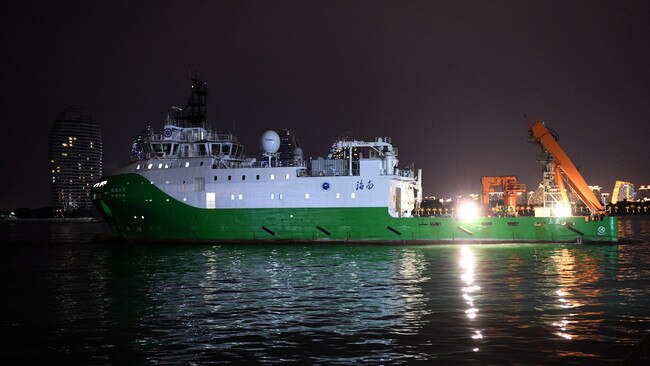China sub rescue ‘a worry for the West’
A significant soft power win for Beijing that also offers an opportunity to map one of the region’s most important straits.

The Chinese navy has begun an unprecedented salvage operation to help recover for free the Indonesian submarine Nanggala — a soft power win for Beijing that also offers an opportunity to map one of the region’s most important straits linking the Indian Ocean and South China Sea, analysts say.
Indonesia has accepted the PLA Navy’s offer to send three vessels, including its most advanced hydrographic survey ship the Tansuo 2, to help lift the 44-year-old submarine, which sank in waters north of Bali during torpedo drills near the Lombok Strait with 53 crew members on board last month.
An Indonesian navy spokesman said the defence ministry had received offers from Australia, the US, Japan, Russia and China to help recover the 1395 tonne naval vessel — in three pieces on the seabed at a depth of 838m — but had accepted Beijing’s offer “because their ships were already close to Indonesia … and it’s completely free”.
The spokesman confirmed that all three Chinese vessels, and 48 specialist People’s Liberation Army deep-sea divers, had begun the salvage operation after the Tansuo arrived in port late on Wednesday, but the Indonesian cable-laying vessel, Timas 1201 — which will help lift the wreck — was still on route.
Two Indonesian navy vessels were also at the site, according to the spokesman, who added: “We need to monitor them so they don’t carelessly take data”.
The Nanggala is Indonesia’s first submarine accident, and the government is under pressure to retrieve the bodies of its lost submariners and determine the cause of the tragedy. Still, its decision to accept China’s offer has raised eyebrows given regional concerns over Beijing’s maritime aggression, and the potential for the PLA navy to lay surveillance sensors in one of the region’s most important shipping straits.
Beijing has made no secret of the potential benefits of the salvage mission, with one submarine expert telling the state-run Global Times that the operation would help further China’s national security objectives. The mission would allow China to “study the maritime military geography of the area where the submarine was wrecked, as well as expanding the international co-operation and influence of our navy in submarine rescue and salvage”, the expert added.
The Lombok Strait is favoured by nuclear-powered submarines because it is deeper and less busy than the Malacca Strait, and because vessels are not required to surface and show their flag while transiting through it. The strait is also heavily used by Australian commercial shipping traffic.
An Australian defence ministry spokesman said HMAS Ballarat — the first foreign vessel to join the search last month — had left the area and Australia had “not been asked to contribute further capabilities to the salvage”.
The Australian understands the US did offer assistance but did not offer to pay for the salvage, which naval experts have estimated could cost up to $200m given the weight of the vessel and the depth to which it has sunk.
Regional security analyst Malcolm Cook told The Australian it was the first time China — and not traditional maritime assistance nations such as the US, Australia and Japan — “would be the provider of external help for a southeast Asian country in a situation like this”.
“If you were to script a movie about how to enhance Chinese soft power diplomacy in Indonesia, I’m not sure you could get a better plot,” Dr Cook said. “The Lombok Strait is the most important strait for submarine traffic, which is the most sensitive of military traffic and hard to track.
“If they can map the area they will have a much better idea of the sea floor and currents in the Lombok Strait which would be of benefit to Chinese submarines. If they are also able to leave sensors in the strait they would be able to track who goes through, which would be very detrimental to those who use it.”
Singapore-based maritime security analyst Collin Koh said the PLA Navy was clearly eager to project a softer image in a region where it has seized and militarised a number of disputed South China Sea islands and regularly breached sovereign maritime boundaries, though likely also had “ulterior motives”.
Dr Koh said the PLA’s deployment of its most sophisticated oceanographic survey vessel rang alarm bells given its ability to perform “all sorts of functions including the placement of sensors and other things that can be left unattended for long periods of time and can transmit data”.
“I would think that would be a huge concern for everybody. Whatever China spends on this, the benefits will probably far outweigh the costs.”
Additional reporting: Chandni Vasandani




To join the conversation, please log in. Don't have an account? Register
Join the conversation, you are commenting as Logout